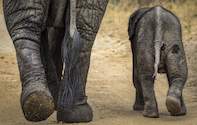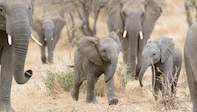
When it comes to social interactions in female elephants, bigger is better is the finding of a new study published in the journal Animal Behaviour. Bigger elephants get first go at any special resources like food, water holes, rubbing posts and mineral resources, with smaller elephants deferring to their elders in a clear size hierarchy.
Using two elephant populations in Kenya and Tanzania that have been extensively studied for many years, the authors of the paper also found that in elephants, as with humans, mothers and daughters and female siblings squabbled a lot amongst themselves.
Serious aggression was reserved for other unrelated elephants that approached the female family groups. When a dispute arose, in nearly every single case smaller females gave way to bigger females, no matter whether the elephants were closely related or not.
Elephant Hierarchy

As elephants continue to grow throughout their life span, the older an elephant is, the bigger it gets, and so moves up in the hierarchy. Different elephant families did not have different ranks that they pass on to their children. This is different to many primates, where a small individual of a highly-ranking family can outrank a larger member of a lowranking family.
Although the things that elephants eat are usually plentiful and widely distributed, something that often causes wild animals to live solitary lives rather than social ones, elephant females stick together in family groups. This is thought to be because they can then help each look after and protect their young, as well as share information on the best places to eat and drink.
Learn more about the African Elephant

 The African Elephant is the world's largest land mammal, and weighs up to 7 tonnes and reaches heights of 3.3 m at the shoulder. Where are E...
The African Elephant is the world's largest land mammal, and weighs up to 7 tonnes and reaches heights of 3.3 m at the shoulder. Where are E...